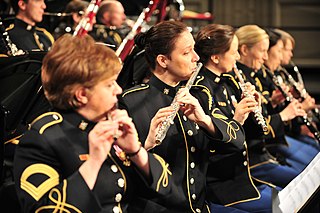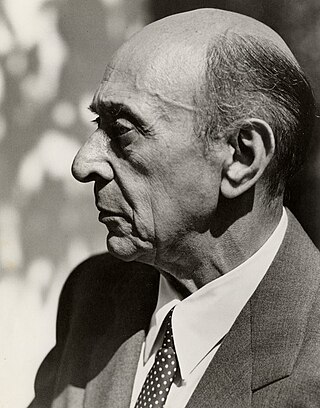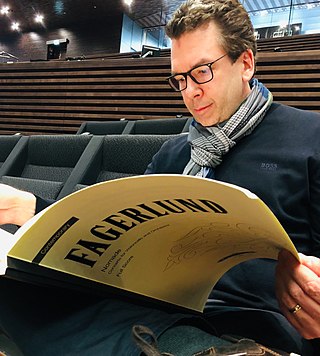A quintet is a group containing five members. It is commonly associated with musical groups, such as a string quintet, or a group of five singers, but can be applied to any situation where five similar or related objects are considered a single unit.
The Bergen Woodwind Quintet is a well-known woodwind quintet based in Bergen, Norway. The ensemble's members are the principal wind musicians of the Bergen Philharmonic Orchestra, also known as Harmonien, which was founded in 1765 and is one of the world's oldest orchestral institutions. The quintet often conducts worldwide tours, performing for live audiences, conducting radio broadcasts, and holding master classes for music students.
Mario Davidovsky was an Argentine-American composer. Born in Argentina, he emigrated in 1960 to the United States, where he lived for the remainder of his life. He is best known for his series of compositions called Synchronisms, which in live performance incorporate both acoustic instruments and electroacoustic sounds played from a tape.

Harald Sigurd Johan Sæverud was a Norwegian composer. He is most known for his music to Henrik Ibsen's Peer Gynt, Rondo Amoroso, and the Ballad of Revolt. Sæverud wrote nine symphonies and a large number of pieces for solo piano. He was a frequent guest conductor of his own works with the Bergen Philharmonic Orchestra.
The Bergen Philharmonic Orchestra is a Norwegian orchestra based in Bergen. Its principal concert venue is the Grieg Hall.
The Grieg Academy is a disputed historical term used to refer to the higher education music programs in Bergen, Norway, as well as various collaborations across music institutions in Bergen. However, since 2016, due to mergers between several Norwegian institutions, the structure of Grieg Academy has changed and its remaining components are expected to be a doctoral research school and various research groups. Specifically, this is due to a merger between the University of Bergen’s Faculty of Humanities with the Bergen Academy of Art and Design, as well as a nearly simultaneous merger between Bergen University College and two other university colleges in western Norway: Stord/Haugesund University College and Sogn og Fjordane University College to become, in January 2017, Western Norway University of Applied Sciences (HVL) The music programs across HVL briefly became the largest music department in western Norway in terms of the number of full time teachers, but this has rapidly changed due to an unofficial policy of not replacing retiring teachers.
Chen Yi is a Chinese-American composer of contemporary classical music and violinist. She was the first Chinese woman to receive a Master of Arts (M.A.) in music composition from the Central Conservatory of Music in Beijing. Chen was a finalist for the 2006 Pulitzer Prize for Music for her composition Si Ji, and has received awards from the Koussevistky Music Foundation and American Academy of Arts and Letters, as well as fellowships from the Guggenheim Foundation and the National Endowment for the Arts. In 2010, she was awarded an Honorary Doctorate from The New School and in 2012, she was awarded the Brock Commission from the American Choral Directors Association. She was elected to the American Academy of Arts and Letters in 2019.
Torstein Aagaard-Nilsen is a Norwegian contemporary composer.
Oslo String Quartet was formed in 1991 by Geir Inge Lotsberg and Per Kristian Skalstad (violins), Are Sandbakken (viola), and Øystein Sonstad (cello). It was among the 1994 prize winners of the London International String Competition, which is among the most prestigious string quartet competitions internationally. In 2007 Skalstad left the quartet in order to pursue a conducting career. Liv Hilde Klokk replaced him at the start of 2008. The quartet regularly at music festivals in Scandinavia and elsewhere, including Wigmore Hall in London and Carnegie Hall in New York. The quartet was awarded Komponistforeningens pris in 1998 and the Kritikerprisen for 1999–2000. Their CD recordings of Carl Nielsen's quartets won them a 1999 "Editor's Choice" nomination in the international journal The Gramophone, which stated, "Artistically it is the finest at any price point ... totally dedicated, idiomatic performance ... full of vitality and spirit and refreshingly straightforward".
Vento Chiaro is a wind quintet founded in 1997 at the Peabody Conservatory of Music in Baltimore, Maryland and now based in the greater Boston area.
Walter Hekster was a Dutch composer, clarinetist and conductor of classical music, specialising in contemporary classical music.

Claude-Paul Taffanel was a French flautist, conductor and instructor, regarded as the founder of the French Flute School that dominated much of flute composition and performance during the mid-20th century.
Gary Alan Kulesha is a Canadian composer, pianist, conductor, and educator. Since 1995, he has been Composer Advisor to the Toronto Symphony Orchestra. He has been Composer-in-Residence with the Kitchener-Waterloo Symphony (1988–1992) and the Canadian Opera Company (1993–1995). He was awarded the National Arts Centre Orchestra Composer Award in 2002.

The Soni Ventorum Wind Quintet was an American wind quintet that was officially founded in 1962 when Pablo Casals asked its members to become the woodwind faculty of his newly founded Conservatory of Music of Puerto Rico. It is known worldwide for its many international tours sponsored by the United States Department of State including three tours of South America and three of Europe. Over 25 original chamber works for winds have been written for the members of Soni Ventorum including compositions by Claude Arrieu, William Bergsma, Jean Francaix, Gerald Kechley, Joseph Goodman, John Verrall, and William O. Smith. In 1972 the quintet won the silver medal at the International Instrumental Ensembles Competition in Rio de Janeiro.

The woodwind section, which consists of woodwind instruments, is one of the main sections of an orchestra or concert band. Woodwind sections contain instruments given Hornbostel-Sachs classifications of 421 and 422, but exclude 423

The Wind Quintet, Op. 26, is a chamber music composition by Arnold Schoenberg, composed in 1923–24. It is one of the earliest of Schoenberg's compositions to use twelve-tone technique.

Sebastian Fagerlund is a Finnish composer. He is described as “a post-modern impressionist whose sound landscapes can be heard as ecstatic nature images which, however, are always inner images, landscapes of the mind”. Echoes of Western culture, Asian musical traditions, and heavy metal have all been detected in his music.
Christoffer Sundqvist is a Finnish clarinettist. Since 2005 he has been first clarinet of the Finnish Radio Symphony Orchestra.

A woodwind quartet is a musical ensemble for four woodwind instruments. Alternatively the term refers to music composed for this ensemble. The most common scoring is flute, oboe, clarinet and bassoon. The ensemble is also often used as a teaching ensemble in schools and universities and as a concertino group in a concerto grosso.







